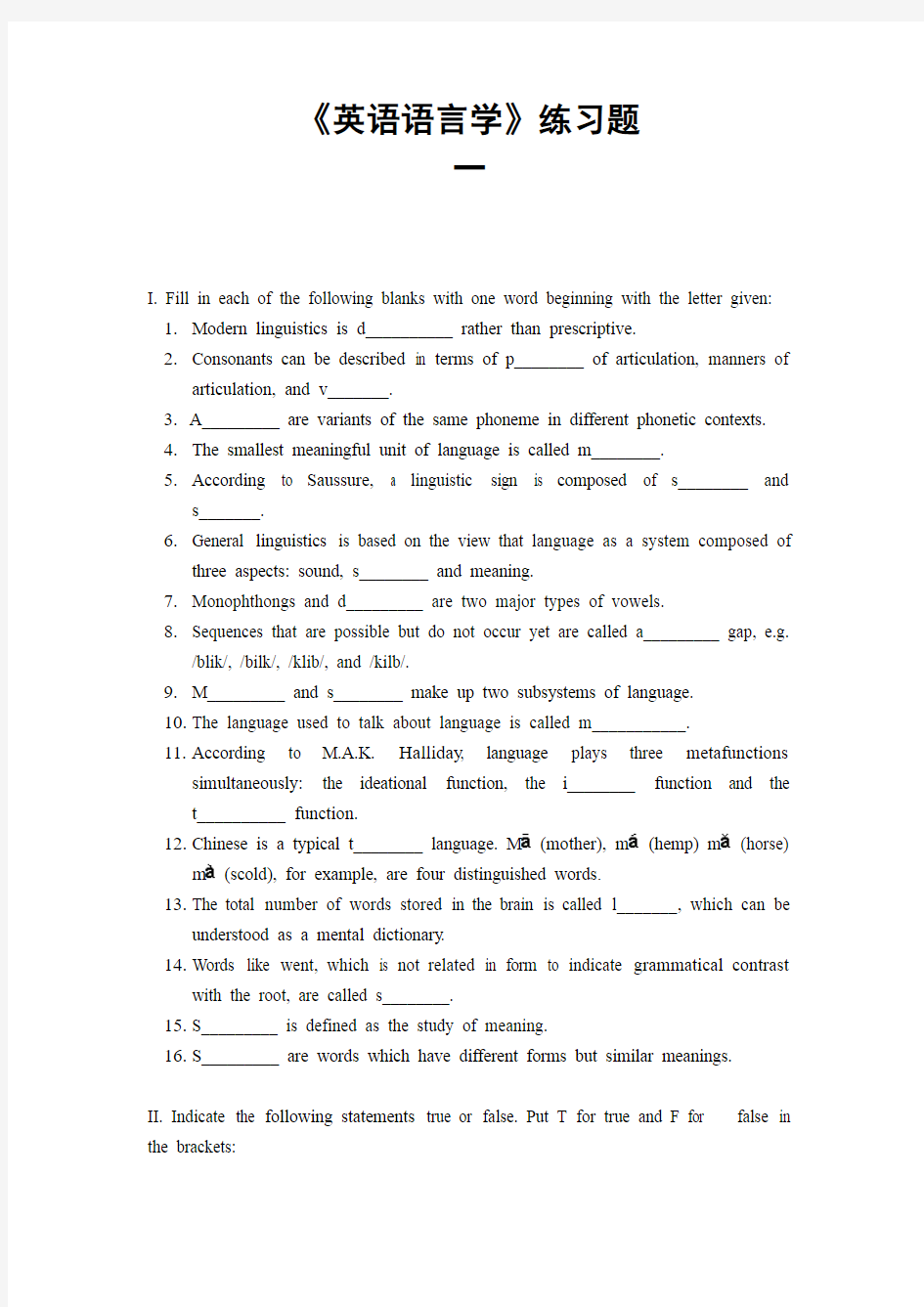《英语语言学》练习题

- 1、下载文档前请自行甄别文档内容的完整性,平台不提供额外的编辑、内容补充、找答案等附加服务。
- 2、"仅部分预览"的文档,不可在线预览部分如存在完整性等问题,可反馈申请退款(可完整预览的文档不适用该条件!)。
- 3、如文档侵犯您的权益,请联系客服反馈,我们会尽快为您处理(人工客服工作时间:9:00-18:30)。
《英语语言学》练习题
一
I. Fill in each of the following blanks with one word beginning with the letter given:
1.Modern linguistics is d__________ rather than prescriptive.
2.Consonants can be described in terms of p________ of articulation, manners of
articulation, and v_______.
3.A_________ are variants of the same phoneme in different phonetic contexts.
4.The smallest meaningful unit of language is called m________.
5.According to Saussure, a linguistic sign is composed of s________ and
s_______.
6.General linguistics is based on the view that language as a system composed of
three aspects: sound, s________ and meaning.
7.Monophthongs and d_________ are two major types of vowels.
8.Sequences that are possible but do not occur yet are called a_________ gap, e.g.
/blik/, /bilk/, /klib/, and /kilb/.
9.M_________ and s________ make up two subsystems of language.
10.The language used to talk about language is called m___________.
11.According to M.A.K. Halliday, language plays three metafunctions
simultaneously: the ideational function, the i________ function and the t__________ function.
12.Chinese is a typical t________ language. M(mother), m(hemp) m(horse)
m(scold), for example, are four distinguished words .
13.The total number of words stored in the brain is called l_______, which can be
understood as a mental dictionary.
14.Words like went, which is not related in form to indicate grammatical contrast
with the root, are called s________.
15.S_________ is defined as the study of meaning.
16.S_________ are words which have different forms but similar meanings.
II. Indicate the following statements true or false. Put T for true and F for false in the brackets:
( ) 1. The Swiss linguist de Saussure regarded the linguistic sign as co mposed of sound image and referent.
( ) 2. Chinese is an agglutinating language.
( ) 3. Not all vowels are voiced.
( ) 4. If segments appear in the same position but the mutual substitution does not result in change of meaning, they are said to be in free variation.
( ) 5. A greenbottle is a type of bottle.
( ) 6. Productivity is the first and foremost striking feature of human language. ( ) 7. Language contains two subsystems, one of speaking and the other of writing.
( ) 8. Language can be used to refer to things real or imagined, past, present or future.
( ) 9. Modern linguistics is prescriptive rather than descriptive.
( ) 10. The study of speech sounds is called Phonology.
( ) 11. The voiceless bilabial stop in pin and the one in spin are in complementary distribution.
( ) 12. Tone is the variation of pitch to distinguish utterance meaning.
( ) 13. Compounding, the combination of free morphemes, is a common way to form words.
( ) 14. In the phrases a herd of cattle, a flock of sheep, both cattle and sheep contain only one morpheme.
( ) 15. The meaning of compounds is always the sum of meaning of the compounds.
III. Multiple Choice
1._________ is the first and foremost striking feature of human language.
A. Duality
B. Arbitrariness
C. Creativity
D. Displacement
2.Which of the following does not belong to the language metafunctions
illustrated by M.A.K. Halliday?
A.Ideational function
B. Interpersonal function
C.Textual function.
D. Logical function
3.The study of speech sounds is called ________.
A. Phonetics
B. Articulatory phonetics
C. Phonology
D. Acoustic Phonetics
4.Every syllable has a(n) _______, which is usually a vowel.
A. onset
B. nucleus
C. coda
D. rhyme
